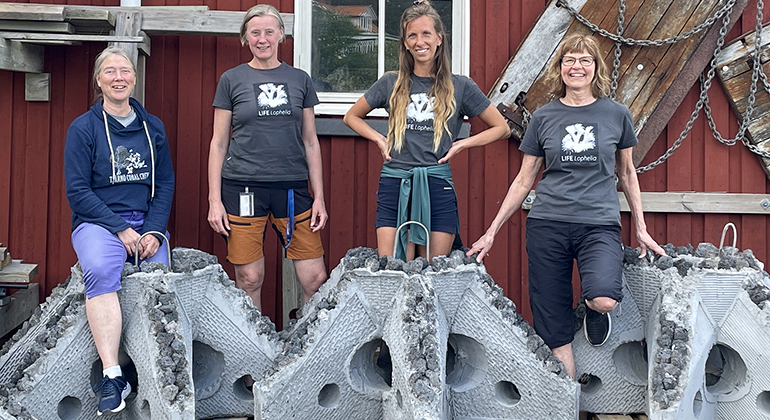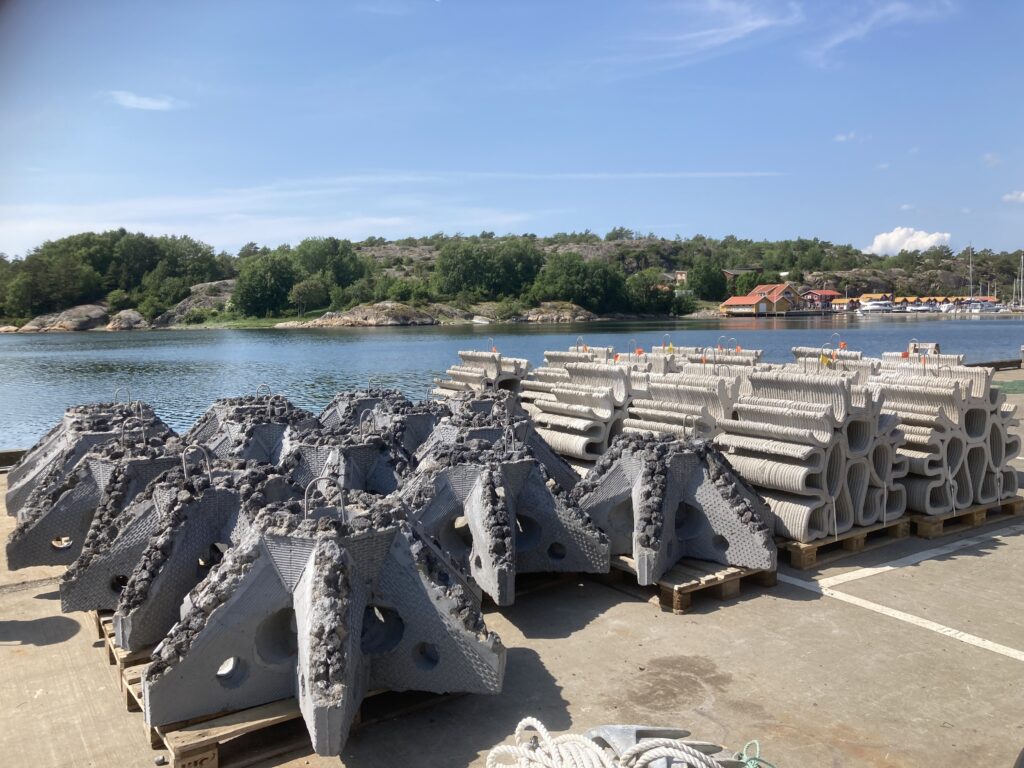
Photo: Susanne Liljenström
After almost five years of preparation, it’s finally time. The specially designed concrete reefs that will give the cold water coral Lophelia pertusa a restart, are lowered to the seabed in northern Bohuslän.
– Coral reefs are the most species-rich environment in the ocean. We have previously had living coral reefs along the west coast that we have destroyed. By manufacturing and placing artificial reef structures in the sea, we hope to be able to restore these valuable environments, says Anita Tullrot, project leader for LIFE Lophelia and Marine Nature Conservation Manager at the County Administrative Board of Västra Götaland.
Thrives in strong water currents
Behind the design of the reefs lies several years of work at the University of Gothenburg’s marine research station on Tjärnö. Ann Larsson is the research leader and says that it is important to find a material that suits the coral larvae, and that is also shaped so that optimal current conditions are created around the reefs
– The Lophelia coral thrives in areas with high current speeds. On a flat bottom surface, the larvae are just swept by, without a chance to get down and get stuck. That’s why we need something that sticks up from the bottom and breaks the strong current, she says.
Slag provides cavities and calcium
To find the right shape of the reefs, Ann Larsson and her colleagues at Tjärnö have investigated the movements of water currents around different structures in special stream aquariums. Eventually, they landed on something resembling a christmas tree base, or star, with six arms and a hole in the middle. On top of the arms, black lava-like lumps of stone have been cast in place. It is slag, a by-product of metal production, that has been shown to have good properties in this context.
– The slag has lots of small cavities where the larvae can crawl in and settle. In addition, it contains calcium and other minerals, and when we investigated the larvae’s interest in different materials, they have been attracted to slag, says Ann Larsson.

Photo: Anita Tullrot
Cultivated coral larvae acting test pilots
To help develop the artificial reefs, the researchers have cultivated coral larvae to act as test pilots. Adult Lophelia corals were collected from a nearby large reef in Norway, and using a method developed at the Tjärnö Laboratory, the researchers have induced the corals to spawn and reproduce in aquariums.
– There were no studies of how the larvae behave around different materials and surfaces when we started. In fact, only we and a research group in Trondheim have managed to produce larvae of Lophelia coral in the lab before, says Ann Larsson.
Handbook shows the way for others
The Lophelia coral is found in the Atlantic Ocean from the northernmost part of Norway, around the British Isles and down to the Mediterranean. Everywhere, the species is declining and threatened by bottom trawling, deep-sea fishing, climate change, oil and gas extraction, and deep-sea mining. An important part of the LIFE Lophelia project is therefore to spread knowledge about how the reefs can be restored.
– We will produce a technical handbook and a film that describes the method we have now developed. In this way, we hope that our experiences can be used elsewhere. There is a great need, says Anita Tullrot.
Developments followed with filming
To create the best possible conditions, fishing bans have been introduced in the six places where the reefs are to be restored. This means that the areas are protected from bottom trawling, but also from fishing with lobster and crayfish cages. In addition, it will be forbidden to anchor in all places.
The development at the reefs will be followed up every three years through an assignment to the Swedish University of Agricultural Sciences, SLU. The follow-up is done with an underwater camera that is lowered to the seabed from a boat.
– The first filming will be done already in September. It will be exciting to see if fish such as dogfish and cod move around the reefs. We believe that the reefs will be an asset for many different species, both sessile and mobile, and thus increase biodiversity in the area, says Anita Tullrot.
Hoping for corals within five years
When there will be corals on the concrete reefs is difficult to predict. Larvae vary in numbers from year to year, then the development time from a larva of 0.2 millimeters to a slightly larger polyp is a year or so. But there are examples where it can happen unexpectedly quickly: When the reef at Väderöarna was examined in 2010, it seemed completely dead, but just three years later, living coral grew over an area of almost 300 square meters on top of dead, slightly larger skeletal parts.
– We have tried to give the coral larvae the best conditions possible. My hope is that we will see live corals on the reefs within five years, says Anita Tullrot.
Text: Susanne Liljenström





